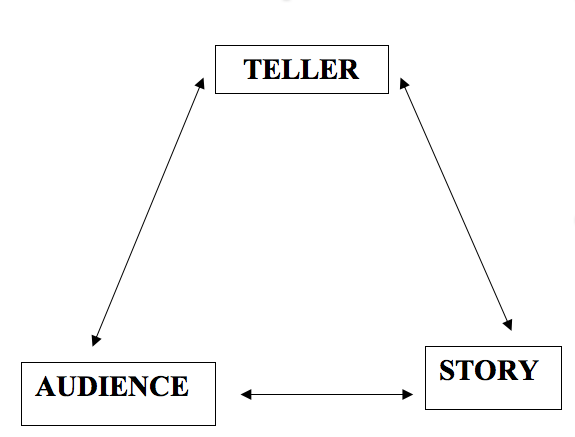|
I posted last year about the importance of matching stories with audiences. I am continuing this theme, focusing on elements that lead to stories connecting with audiences, starting with audiences that are likely to be more receptive to the story or a message behind the story. If a story is told or shared to entertain an audience, the primary measure of success might be the degree to which the audience enjoyed the story. However, if a story is told or shared for the purpose of advocacy or awareness, in order to be considered successful, it first has to connect with an audience and then make an impact on some members of that audience, producing some change in beliefs, attitude, or action. I think that it is useful to look at the triangle which oral storytellers use to describe the connections between the teller, the story itself, and the audience. For an oral story to be effective, all of these connections need to exist. The teller needs to be emotionally connected to the story—there is something in the story that produces an emotional link. In addition, audience members need to be able to find common ground on some level with both the story and the teller in order for the story to resonate with them.
For any audience, regardless of the medium, there are criteria which can be used to determine the strength of the connection between a story and audience:
In addition, if a story is told for the purpose of advocacy or awareness, there needs to be an “Ask.” If, at the end of a story, there is not an Ask—if individuals or groups watching or listening the story are not asked to do something such as take action or change the way one thinks about an issue—then the story can only be appreciated as interesting or even dismissed entirely, and there will be no lasting impact. Recently, I went to a lecture in the informal setting of a barn on a farmette. The speaker was Cindy Crosby, a steward supervisor for the Schulenberg Prairie at the Morton Arboretum in Illinois and a writer, teacher, and lecturer on the tallgrass prairie and nature conservation. She spoke about how prairies once covered 40% of this country, and now it is only 1%. She intertwined the story of prairie loss and the importance of prairies with her own story about how a general fascination with nature and the outdoors has led to her becoming an educator and advocate for tallgrass prairie preserves. The lecture was filled with anecdotes, some scientific information, history, and humor. There were about thirty of us gathered for that lecture. One person who followed Cindy’s weekly blog had driven two hours to listen and to meet her. He was the only member of the audience actively involved in stewardship of a prairie. Several people had come because they were very interested in turning part of their yards or property into prairie, and others simply because the topic or the idea of a lecture in a barn were intriguing. How effectively did she connect with her audience? Based on the high percentage of those attending who bought books and the buzz of conversation after the lecture, the answer would be that she was successful. Using the TELLER-STORY-AUDIENCE triangle, Cindy Crosby had accurately read the audience as people who were interested but not knowledgeable. She was personable, and the few times she used technical language she readily clarified the terms. Instead of explaining prairie plant roots in scientific terms or measurements, she invited two children from the audience to stretch a piece of yarn to its 18 foot length. Illustrating the enormous depth of the root in a way that enlivened the lecture. Her description of the joy and wonder she experienced while walking through a prairie connected with the emotions of the audience. We wanted to be there in those moments, watching the movement of the tall grass in the wind, marveling at a dragonfly. Cindy also had a very soft Ask, which was well received. She invited us to learn about the life prairies, to visit prairies near us, and suggested that we plant a small section of our yards with prairie plants, helping us to visualize the butterflies and birds that might visit our yards if we did. One thing that contributed to the success of her talk was that we were a self-selected audience, coming in with some interest in the topic and predisposed to be open to learning. Connecting with an audience that was receptive was certainly easier than speaking to a group of people who see a prairie as a collection of weeds, with nothing about the prairie that a John Deere tractor, seed corn, and fertilizer could not fix. Connecting with an audience whose views are greatly different than, or perhaps antagonistic to, the awareness or advocacy message one is promulgating is certainly more difficult than connecting with a friendly and receptive audience. In the next blog post, I will address how one communicates with and connects with a less receptive audience.
0 Comments
|
Storying the Human Experience
Yes, it's a grandiose title. But, as Flannery O'Connor once said, "A story is a way to say something that can't be said any other way." Archives
November 2019
Categories |


 RSS Feed
RSS Feed